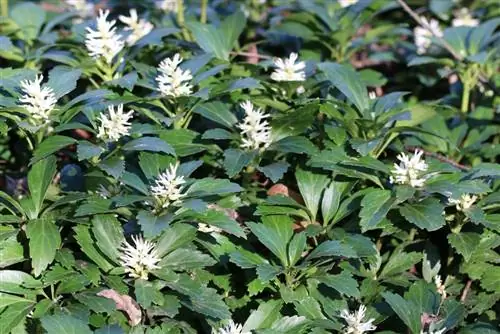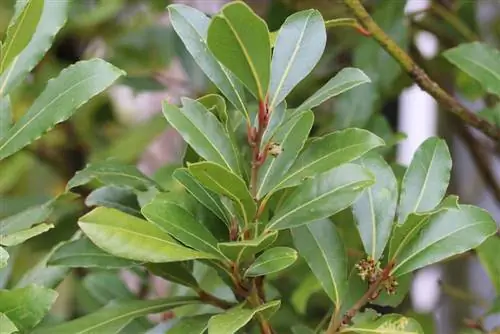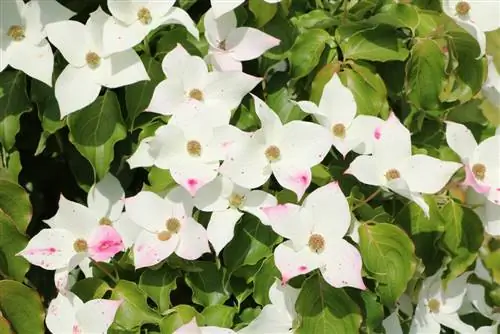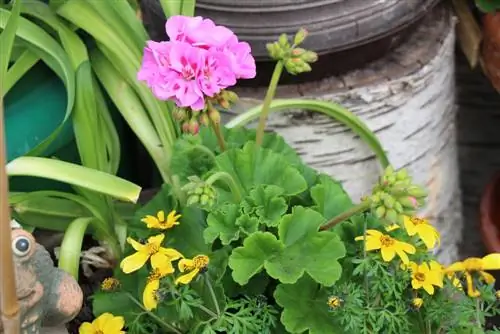- Author admin [email protected].
- Public 2023-12-17 03:39.
- Last modified 2025-06-01 06:48.
Geraniums are among the most popular flowering plants for balconies and beds. And rightly so. Because its easy-care character is only surpassed by its long-lasting blooms. Despite their frugal side, they of course have demands that must be met. Geraniums are among the most popular flowering plants for balconies and beds. And rightly so! Because its easy-care character is only surpassed by its long-lasting blooms. Despite their frugal side, they of course have demands that must be met. If you take these into account, you can enjoy the decorative plants for years to come.
The pelargoniums known as geraniums delight with their rich flowers and wide variety of colors. They are also extremely undemanding and are therefore a good choice for those new to plant care. However, there are a few things that need to be taken into account to ensure that the plant thrives and the flowers remain in bloom. At least if the joy is not meant to be short-lived. However, with the right instructions and the right location, growing geraniums is very easy.
Location
Geraniums are true sun worshipers and therefore do well with a location on the south-facing balcony. A planting spot in front of a south wall or a sheltered bed is also suitable. Rain and strong winds can damage plants. A covered location or a bright spot under other plants is therefore ideal.
Substrate
The geranium is a bit tricky when it comes to choosing the substrate. If it is placed in the wrong soil, it will quickly either barely grow or even die. The simplest solution is special geranium soil that has already been pre-fertilized. High-quality, humus-rich potting soil - ideally from specialist retailers and not from the supermarket - can also be used.
Plants
When it comes to planting geraniums, speed is more important than the actual timing. It is best to put the plants in the ground and place them in the sun immediately after purchase. Because even brief darkness quickly damages them in spring.
Ensuring water drainage in the pot, bucket or box is crucial when using it. Ideally, in addition to the holes in the bottom of the vessel, a drainage layer made of pottery shards and gravel is added. It is also important to take the following factors into account:
- Do not press substrate firmly
- leave a watering edge of about 2 cm above the top so that the water does not end up in the lower apartment neighbor
- The distance between plants should be at least 25 cm
- Calculate at least two and a half liters of volume per geranium, more is better
- Plant out only when there is no frost at all
Tip:
In windy locations, a low trellis can be used to protect against damage.
Pouring
Geraniums are able to store a surprising amount of water and are therefore forgiving if watering is occasionally forgotten.
However, that doesn't mean that watering should be done too sparingly. Geraniums grown in pots are best submerged. All others are watered generously but not drowned. Waterlogging should be completely avoided - but in midsummer, two waterings a day make sense.
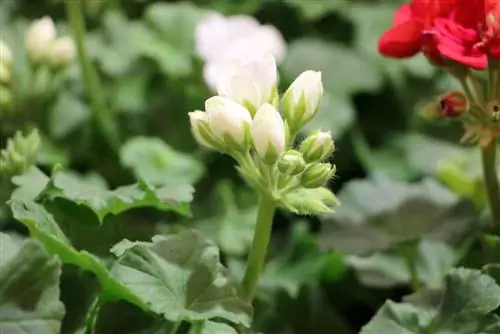
The reason for this lies in the geranium's self-protective behavior. If it doesn't have enough water available, its surface area will be reduced. And quickly. Buds, flowers and leaves are shed and growth stops. If the plants are generally too dry, they will quickly stop blooming at all. If the watering behavior is changed accordingly, the plants will recover, but until then the beauty is over.
Fertilize
The lush flowers of geraniums require large amounts of nutrients. There is therefore no way around fertilizing if the plants are to bloom in the first place and then last. Use in pre-fertilized geranium soil, a weekly application of liquid geranium fertilizer or the use of slow-release fertilizer are suitable for this.
Blend
The cuttings for the geraniums are the same as the watering - a lot, but not too much. In autumn, when the plants are put away for the winter, they are stripped of their leaves and then shortened all around by about a third. This shockingly naked measure reduces evaporation and nutrient consumption. This conserves the geranium's strength. The waste also reduces the risk of diseases and pest infestations.
The second cutting takes place in spring when the plants leave their winter quarters again. However, this is much gentler; only the interfaces that have now dried out are removed. If thin shoots have already formed at the winter location, these must also be cut off.
Wintering
Overwintering geraniums is quite easy. The plants are brought indoors before the first frost. Here they should be in a bright place where the temperature is 5 to 10 °C. In preparation for moving in, the substrate can be kept a little drier. And of course the waste is crucial. When the cold season comes to an end, it is advisable to slowly acclimate the geraniums. Two to three weeks before they are released, they can move to a warmer and brighter temporary location.
Repotting
When the geraniums leave their winter quarters and are cut for preparation, the substrate should also be changed. A larger container is not always necessary, but is advisable if you have a very large, strong root ball. Felty, knotted root areas can also be corrected slightly.
Propagation
Geranium propagation is very easy and possible from spring to autumn. All you need are shoots that are about ten centimeters long and already have a few leaves. These can easily be branches that broke off in the last storm. Then it continues as follows:
- The cuttings are freed from the lower leaves and buds.
- The shoots are placed in moist potting soil with a smooth, clean cut edge. A depth of two centimeters is sufficient.
- The cuttings should then be moved to a very bright and warm place, but where they are not exposed to the blazing sun.
Roots have already formed after three weeks if the young plants are kept evenly moist and the other conditions are right.
Typical pests and diseases
If the geraniums are cared for properly, they hardly suffer from diseases. Due to the deterrent effect of the plants, pests only appear in extremely exceptional cases. However, so-called geranium or pelargonium rust can occur, which is a very contagious fungal infection. If rust-colored spots are noticed on the leaves, treatment with appropriate fungicides should be carried out immediately.
Frequently asked questions
Are geraniums poisonous?
Yes, geranium is poisonous to both humans and animals. They should therefore be kept out of the reach of small children and pets.
Can geraniums be cultivated outdoors?
The geranium can be planted in the bed - but since it is not hardy, it will die with the first frosts.
What you should know in brief
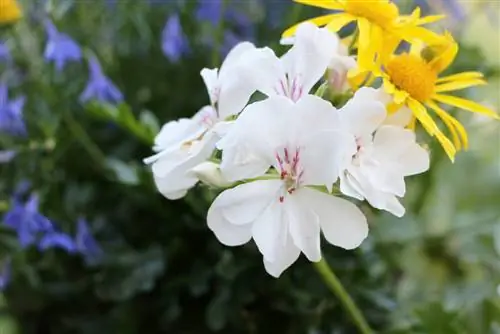
Geraniums (actually: pelargoniums) are by far the most popular balcony flowers. This can be explained primarily by the fact that they are very robust and very flowery. Above all, the splendor of the colors of geraniums is endless. The most popular colors are still red, white and pink, but they are now also available in a rich purple and even two-tone varieties with smaller flowers are now available. In addition, a distinction is made between hanging and standing geraniums.
- The big advantage of geraniums is that they are very easy to care for and you can overwinter them.
- In summer you have to water them regularly and heavily. It is important that excess water can drain out of the flower box.
- To avoid drying out from below, you can place so-called watering mats or old newspaper on the bottom of the flower box.
- Geraniums should also be fertilized occasionally with flower fertilizer. A normal flower fertilizer for balcony and house plants is sufficient here.
The nutrients ensure that the geraniums bloom particularly well. Old flower heads should be removed. You should break off the flower umbel at the bottom of the stem - the flower umbels are usually easy to remove. The more air the plant gets, the more eagerly it can bloom. Old flower umbels prevent new flowers from sprouting.
- In the fall you don't have to throw away the geraniums, you can overwinter them in the cellar.
- To do this, cover the geraniums and put them in the cellar.
- It is not necessary to water the geraniums over the winter.
- In spring the geranium must be potted in fresh potting soil and the dry leaves must be removed.
- After a few weeks, new shoots will appear and you can enjoy the flowers for another year.


